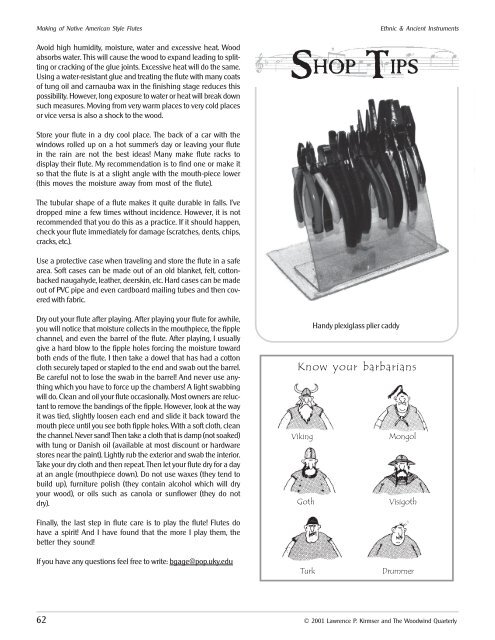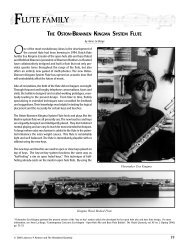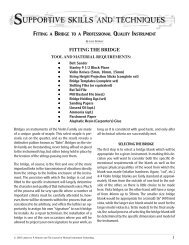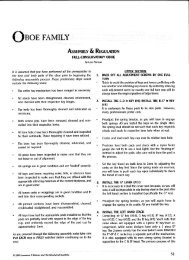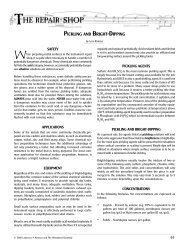The Native American Flute - Music Trader Index Page
The Native American Flute - Music Trader Index Page
The Native American Flute - Music Trader Index Page
You also want an ePaper? Increase the reach of your titles
YUMPU automatically turns print PDFs into web optimized ePapers that Google loves.
Making of <strong>Native</strong> <strong>American</strong> Style <strong>Flute</strong>s Ethnic & Ancient Instruments<br />
Avoid high humidity, moisture, water and excessive heat. Wood<br />
absorbs water. This will cause the wood to expand leading to splitting<br />
or cracking of the glue joints. Excessive heat will do the same.<br />
Using a water-resistant glue and treating the flute with many coats<br />
of tung oil and carnauba wax in the finishing stage reduces this<br />
possibility. However, long exposure to water or heat will break down<br />
such measures. Moving from very warm places to very cold places<br />
or vice versa is also a shock to the wood.<br />
Store your flute in a dry cool place. <strong>The</strong> back of a car with the<br />
windows rolled up on a hot summer’s day or leaving your flute<br />
in the rain are not the best ideas! Many make flute racks to<br />
display their flute. My recommendation is to find one or make it<br />
so that the flute is at a slight angle with the mouth-piece lower<br />
(this moves the moisture away from most of the flute).<br />
<strong>The</strong> tubular shape of a flute makes it quite durable in falls. I’ve<br />
dropped mine a few times without incidence. However, it is not<br />
recommended that you do this as a practice. If it should happen,<br />
check your flute immediately for damage (scratches, dents, chips,<br />
cracks, etc.).<br />
Use a protective case when traveling and store the flute in a safe<br />
area. Soft cases can be made out of an old blanket, felt, cottonbacked<br />
naugahyde, leather, deerskin, etc. Hard cases can be made<br />
out of PVC pipe and even cardboard mailing tubes and then covered<br />
with fabric.<br />
Dry out your flute after playing. After playing your flute for awhile,<br />
you will notice that moisture collects in the mouthpiece, the fipple<br />
channel, and even the barrel of the flute. After playing, I usually<br />
give a hard blow to the fipple holes forcing the moisture toward<br />
both ends of the flute. I then take a dowel that has had a cotton<br />
cloth securely taped or stapled to the end and swab out the barrel.<br />
Be careful not to lose the swab in the barrel! And never use anything<br />
which you have to force up the chambers! A light swabbing<br />
will do. Clean and oil your flute occasionally. Most owners are reluctant<br />
to remove the bandings of the fipple. However, look at the way<br />
it was tied, slightly loosen each end and slide it back toward the<br />
mouth piece until you see both fipple holes. With a soft cloth, clean<br />
the channel. Never sand! <strong>The</strong>n take a cloth that is damp (not soaked)<br />
with tung or Danish oil (available at most discount or hardware<br />
stores near the paint). Lightly rub the exterior and swab the interior.<br />
Take your dry cloth and then repeat. <strong>The</strong>n let your flute dry for a day<br />
at an angle (mouthpiece down). Do not use waxes (they tend to<br />
build up), furniture polish (they contain alcohol which will dry<br />
your wood), or oils such as canola or sunflower (they do not<br />
dry).<br />
Finally, the last step in flute care is to play the flute! <strong>Flute</strong>s do<br />
have a spirit! And I have found that the more I play them, the<br />
better they sound!<br />
If you have any questions feel free to write: bgage@pop.uky.edu<br />
SHOP TIPS<br />
Handy plexiglass plier caddy<br />
Know your barbarians<br />
Viking Mongol<br />
Goth Visigoth<br />
Drummer<br />
62 © 2001 Lawrence P. Kirmser and <strong>The</strong> Woodwind Quarterly<br />
Turk


